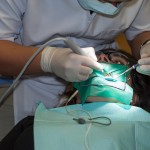
In comparison with conventional root canal therapy vital pulp therapy (pulp capping, partial pulpotomy, and full pulpotomy) is a more conservative approach. It can be used in cases of non-carious exposure, reversible pulpitis in the absence of periapical pathology and in immature teeth to facilitate root development. However accurate diagnosis of pulpal disease is difficult so predicting the long-term success of vital pulp therapy is challenging.
The aim of this review was to evaluate the association of preoperative factors or intraoperative factors with treatment outcomes of vital pulp therapy over a 1-year follow- up period.
Methods
Searches were conducted in the Cochrane Library, Medline/PubMed, Embase, Google Scholar and ProQuest Dissertations and Theses. Databases. Randomised controlled trials (RCTs) published since 2000 with a minimum follow-up period of 12 months were considered. RCTs had to have a pre-operative diagnosis, details of procedure and materials used and clearly defined success criteria. Two reviewers independently screened and selected studies, extracted data and used the Cochrane risk of bias tool to assess studies. GRADE (The Grading of Recommendations, Assessment, Development and Evaluation) was used to assess overall quality and meta-analyses conducted.
Results
- 14 RCTs were included.
- Studies were conducted in China, Egypt, Germany, India, Iran, Jordan, Korea, Spain, Thailand and Turkey.
- Included teeth had initial diagnoses of reversible pulpitis due to deep caries, irreversible pulpitis without periapical lesions, or permanent teeth with traumatic pulp exposure.
- Vital pulp therapy (VPT) techniques reported included direct pulp capping (DPC), partial pulpotomy (PP), and full pulpotomy (FP).
- 2 studies were considered to be at low risk of bias, 9 has some concerns with 3 being at high risk of bias.
- Meta-analysis shows a pooled success rate for trials using contemporary capping materials including mineral trioxide aggregate (MTA) and other bioceramic materials of 93.2% (95%CI; 91-6% to 94.9%) [low certainty evidence]. Subgroup analyses for type of procedure, stage of tooth development, preoperative diagnosis and aetiology are shown in the table below.
- Laser-assisted VPT did not show significantly better outcomes than conventional VPT, Risk ratio = 1.19 (95%CI; 0.95 to 1.49) [3 studies, very low certainty evidence].
- 3 studies reported tooth discolouration in MTA groups.
| No of studies | Success rate (95%CI) | |
| Pooled VPT | 12 | 93.2% (91-6% to 94.9%) |
| Partial pulpotomy | 4 | 92.6% (89.4% to 95.9%) |
| Full pulpotomy | 4 | 89.1% (82.7% to 95.5%) |
| Direct pulp capping | 3 | 94.8% (90.7% to 98.8%) |
| Mixed techniques | 1 | 93.9% (87.2% to 100.0%) |
| Immature permanent teeth | 5 | 91.1% (87.2% to 95.1%) |
| Mature permanent teeth | 4 | 93.1% (90.2% to 96.0%) |
| Permanent teeth (unspecified) | 3 | 94.5% (91.2% to 97.8%) |
| Normal pulp or reversible pulpitis | 3 | 93.3% (89.6% to 97.1%) |
| Irreversible pulpitis | 3 | 93.8% (90.7% to 97.0%) |
| Unspecified or mixed pulp diagnosis | 6 | 92.0% (89.0% to 95.1%) |
| Caries | 7 | 92.2% (89.3% to 95.1%) |
| Trauma | 2 | 88.7% 82.4% to 95.0%) |
| Mixed/unspecified aetiology | 3 | 94.3% (92.1% to 96.5%) |
Conclusions
The authors concluded: –
With very low to low certainty of evidence, this study concluded that VPT using contemporary bioceramic materials was an efficacious treatment modality to treat permanent teeth with a 93% success rate. The aetiology of the pulpal diseases, the selection of materials (limited to contemporary materials), the preoperative diagnosis, and the adjunct use of a laser had no significant correlation with treatment prognosis. No major adverse effects of VPT were reported, except for tooth discoloration associated with MTA.
Comments
The protocol for the review is available on the PROSPERO and a number of major databases have been searched. The reviews have only included RCTs published since 2000 as the focus is on contemporary materials. The 14 studies involved a total of 1147 teeth with 6 of the 14 studies reporting results at 12 months and 4 with follow up periods of 2 years or more. The main findings indicate an overall success rate of 93.2% (95%CI; 91-6% to 94.9%) with the overall certainty of the evidence being assessed as low. A number of subgroup analyses were conducted, and these show some small variations in success rates depending on techniques, aetiologies, and capping materials used. However, the number of studies contributing to the majority of these analyses are small, so they need to be interpreted cautiously. Pulpotomy, partial pulpotomy and direct pulp capping for permanent teeth are areas that have been covered by other reviews ( Dental Elf – 25th Jan 2021, Dental Elf – 1st Nov 2019, Dental Elf – 10th Jul 2019) all showing high rates of success.
Links
Primary Paper
Sabeti M, Huang Y, Chung YJ, Azarpazhooh A. Prognosis of vital pulp therapy on permanent dentition: a systematic review and meta-analysis of randomized controlled trials. J Endod. 2021 Aug 31:S0099-2399(21)00602-6. doi: 10.1016/j.joen.2021.08.008. Epub ahead of print. PMID: 34478787.
Other references
Dental Elf – 25th Jan 2021
Dental Elf – 1st Nov 2019
Dental Elf – 10th Jul 2019
Dental Elf – Pulp capping blogs
